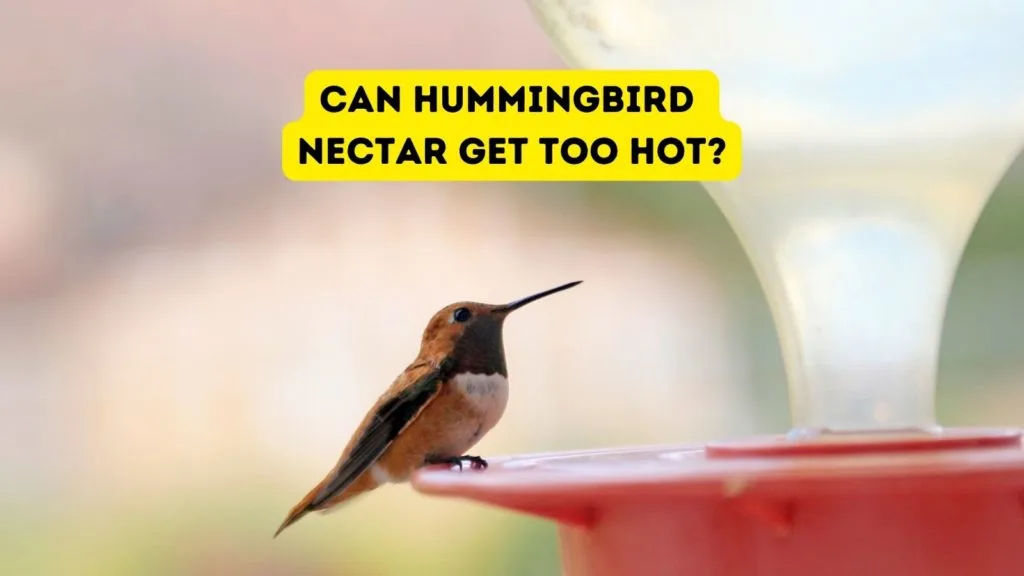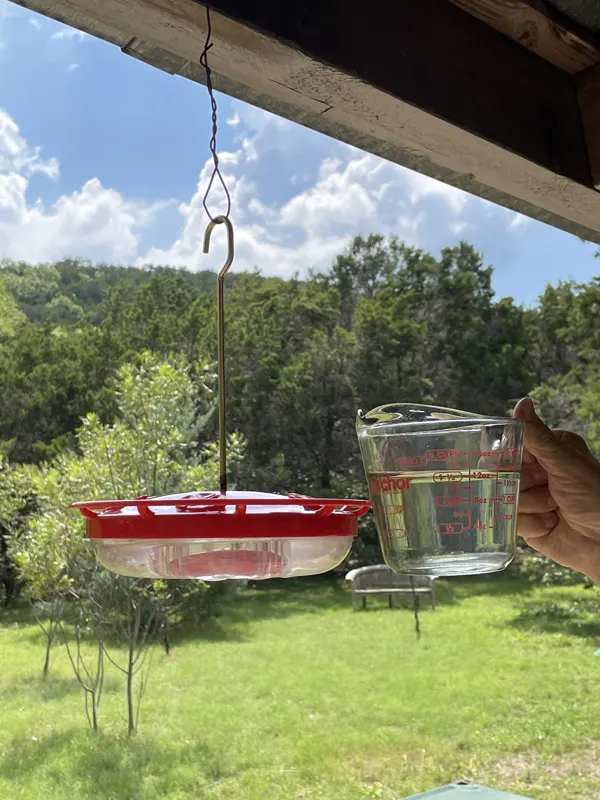We love to attract hummingbirds to our home during the warm weather months by using hummingbird nectar feeders. However, a crucial aspect often overlooked is the temperature of the nectar, especially on hot summer days. It’s essential to understand that hummingbird nectar can indeed get too hot, and serving it without proper cooling can be detrimental to these delicate birds.

Why Temperature Matters
Hummingbirds, with their high metabolism, are particularly sensitive to the quality and temperature of the nectar they consume.
In nature, the nectar they feed on from flowers is typically cool, shielded from direct sunlight by the foliage. This natural setup provides an optimal feeding environment.
However, artificial feeders exposed to direct sunlight can heat the nectar to temperatures much higher than natural nectar. This can lead to several issues:
- Health Risks: Hot nectar can harm a hummingbird’s delicate throat and tongue, causing discomfort or injury. Moreover, extreme temperatures can alter the chemical composition of the nectar, potentially making it harmful.
- Fermentation and Bacterial Growth: Warm temperatures accelerate fermentation and bacterial growth in sugar water. Consuming spoiled nectar can lead to serious health problems for hummingbirds, including potentially fatal infections.
- Unattractive to Birds: Hummingbirds may avoid nectar that is too warm, leading them to seek other food sources. This defeats the purpose of setting up a feeder to attract these birds.
Cooling Nectar Before Serving
Temperature plays a significant role in hummingbird nectar preparation, just like that perfect brew of your morning tea. Serving up hummingbird nectar too hot can cause injury to our tiny feathered friends just as readily as the wrong temperature can lead to spoilage and fermentation.
Of course, when you make the nectar, it will be hot so that the sugar will dissolve.
When preparing homemade nectar, heating it at around 65 degrees Celsius (149°F) helps dissolve the sugar properly without degrading any nutritional properties.
Once prepared, allow the solution to cool down before feeding it to your aerial friends. Make sure it is room temperature or cooler – usually between 15-24°C (59-75°F). This not only ensures their safety but also makes for more refreshing sustenance during hotter weather. Remember those warm summer days when a cold drink was paradise? Well, birds aren’t much different!
Keeping the Nectar Cool Outside
When it comes to keeping hummingbird nectar cool outdoors, there are a few creative strategies that can make all the difference.
Storing your feeders in a shaded location will help keep the nectar’s temperature down. We hang our feeders from the porch overhang which keeps them out of the sun in the heat of the day. Our summer days often reach 100 degrees F or hotter so the shade really helps to keep the nectar cooler.

We also use a feeder with an opaque plastic top rather than a tall glass feeder, which lets in more light and heat.
Replace the nectar frequently, at least every two days during hot weather, to prevent fermentation and spoilage.
Also, clean your feeders thoroughly during each refill to prevent mold and bacteria buildup, which can be accelerated by higher temperatures.
Providing a safe and welcoming environment for hummingbirds involves more than just hanging a feeder. By understanding the effects of temperature on hummingbird nectar and taking steps to ensure it remains cool, bird lovers can help these fascinating creatures thrive, especially during the challenging summer months. Remember, the health and safety of these birds depend significantly on the care and thought put into the feeding process.
More Hummingbird Posts
How Big Are Baby Hummingbirds?
Can Hummingbirds Predict Hurricanes?
- 8 Letter Bird Names - August 14, 2024
- 7 Letter Bird Names - August 14, 2024
- 7 Birds Named After Famous People - July 23, 2024
